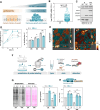The IGF2BP1 oncogene is a druggable m6A-dependent enhancer of YAP1-driven gene expression in ovarian cancer
- PMID: 40008228
- PMCID: PMC11850222
- DOI: 10.1093/narcan/zcaf006
The IGF2BP1 oncogene is a druggable m6A-dependent enhancer of YAP1-driven gene expression in ovarian cancer
Abstract
The Hippo/YAP1 signaling pathway regulates normal development by controlling contact inhibition of growth. In cancer, YAP1 activation is often dysregulated, leading to excessive tumor growth and metastasis. SRC kinase can cross talk to Hippo signaling by disrupting adherens junctions, repressing the Hippo cascade, or activating YAP1 to promote proliferation. Here, we demonstrate that the IGF2 messenger RNA-binding protein 1 (IGF2BP1) impedes the repression of YAP1 by Hippo signaling in carcinomas. IGF2BP1 stabilizes the YAP1 messenger RNA (mRNA) and enhances YAP1 protein synthesis through an m6A-dependent interaction with the 3' untranslated region of the YAP1 mRNA, thereby increasing YAP1/TAZ-driven transcription to bypass contact inhibition of tumor cell growth. Inhibiting IGF2BP1-mRNA binding using BTYNB reduces YAP1 levels and transcriptional activity, leading to significant growth inhibition in carcinoma cells and ovarian cancer organoids. In contrast, SRC inhibition with Saracatinib fails to inhibit YAP1/TAZ-driven transcription and cell growth in general. This is particularly significant in de-differentiated, rather mesenchymal carcinoma-derived cells, which exhibit high IGF2BP1 and YAP1 expression, rendering them less reliant on SRC-directed growth stimulation. In such invasive carcinoma models, the combined inhibition of SRC, IGF2BP1, and YAP1/TAZ proved superior over monotherapies. These findings highlight the therapeutic potential of targeting IGF2BP1, a key regulator of oncogenic transcription networks.
© The Author(s) 2025. Published by Oxford University Press on behalf of NAR Cancer.
Conflict of interest statement
None declared.
Figures






References
MeSH terms
Substances
LinkOut - more resources
Full Text Sources
Medical
Research Materials
Miscellaneous

